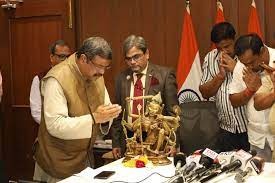Making irrational claims does not make territory yours, according to Chinese tradition, said foreign minister S. Jaishankar on a map of China
Arunachal Pradesh and Aksai Chin in India were shown on a map released by China the day before, but Minister of External Affairs (MEA) S. Jaishankar called the publication of the image “abusrd” and said that it is a longstanding practice for China to publish such maps.
According to Jaishankar, China has a pattern of issuing maps that claim the territory of others dating back to the 1950s, and this practice makes no difference.
On a map released by China on Monday, portions of Ladakh and Arunachal are labeled as Chinese territory. It also included Taiwan, which it views as a renegade province, as part of its own territory, along with the contentious South China Sea.
Jaishankar stated, “China has even put out maps in the past which claim territories which are not China’s and which belong to other countries,” during a conversation at an event organised by NDTV. It’s a longstanding practice of theirs. It is not a novel concept. It began in the 1950s. Therefore, it is not sufficient to claim areas on a map, some of which are a part of India. These are inextricably linked to India.
Jaishankar said that the Indian government is quite clear on the definition of Indian territory.
“This administration has made it very clear what we must do to protect our borders. That is already evident at our borders. Therefore, in my opinion, there should be no question. Making illogical claims won’t make someone else’s land your own. Let’s be quite clear about this, Jaishankar stated.
Since the 1950s and 1960s, China has been impermissibly occupying Aksai Chin, a region in the extreme east of the union territory of Ladakh. China began encroaching on territory in the area in the 1950s and expanded its dominance after winning the India-China War in 1962.
The majority of it is under Chinese occupation, which took control of the territory in the 1950s and strengthened its military control over it during the 1962 India-China War by rejecting all Indian efforts to negotiate boundary issues diplomatically.China claimed that Aksai Chin was a part of the ancient and medieval Chinese kingdom and invaded it. It is a comfortable assertion from a period when borders did not have the same sacredness as they do now, said Prabhash K. Dutta in India now.
In regards to Arunachal, China has long claimed it as its own. Both claims have their origins in Tibet’s historical claims and Beijing’s claim of possession of Tibet. According to the Chinese, as Tibet is part of China, so too are Tibet’s territorial claims to Ladakh and Arunachal Pradesh.
Jawaharlal Nehru, the country’s prime minister at the time, said in Lok Sabha in 1959 that the Tibetan administration had pushed its territorial claims soon after the country gained independence in 1947.
It’s true that our mission in Lhasa transmitted to us a telegraph from the Tibetan office in Lhasa reporting that Tibetan land on the border between India and Tibet had been returned. We responded by requesting confirmation that the Tibetan administration intended to maintain ties on the current basis until fresh agreements were made on whatever actions either side may want to take.
The Chinese claim in that area is heavily reliant on the Buddhist monastery at Tawang in Arunachal. It regards it as a component of southern Tibet.
The Tawang monastery cannot ever be separated from Tibet since it is a vital component of the Tibetan Gelug theocratic institution, according to the broader Tibetan worldview.Until 1938, British India was unable to do anything to implement the Simla Convention, according to Phunchok Stobdan in his book The Great Game in the Buddhist Himalayas: India and China’s Quest for Strategic Dominance. In practice, Lhasa continued to exercise complete spiritual and temporal power over Monyul (Tawang).







